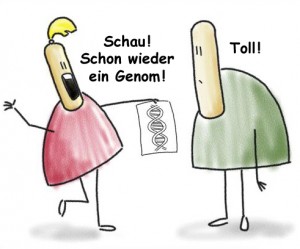 Vor nicht einmal 14 Tagen krabbelten zwei Ameisenarten in die Liste der sequenzierten Organismen (Science 329: 1068-71), letzte Woche kam dann der Apfel dazu (Nature Genetics, pub. online 29. August 2010), vorgestern flatterte noch schnell der Truthahn herein (PLoS Biol 8(9): e1000475) — und gestern verkündeten gerade mal elf Autoren das erste „irische Genom“ (Genome Biology 2010, 11:R91). Dazwischen posaunten die Medien noch etwas voreilig das Weizengenom hinaus, was das offizielle International Wheat Genome Sequencing Consortium allerdings in dieser Endgültigkeit erstmal wieder zurücknahm.
Vor nicht einmal 14 Tagen krabbelten zwei Ameisenarten in die Liste der sequenzierten Organismen (Science 329: 1068-71), letzte Woche kam dann der Apfel dazu (Nature Genetics, pub. online 29. August 2010), vorgestern flatterte noch schnell der Truthahn herein (PLoS Biol 8(9): e1000475) — und gestern verkündeten gerade mal elf Autoren das erste „irische Genom“ (Genome Biology 2010, 11:R91). Dazwischen posaunten die Medien noch etwas voreilig das Weizengenom hinaus, was das offizielle International Wheat Genome Sequencing Consortium allerdings in dieser Endgültigkeit erstmal wieder zurücknahm.
Wie auch immer, Genome sequenzieren ist schon lange kein Hexenwerk mehr. Und sofern man nicht gerade ein spezielles Interesse an dem jeweiligen Organismus hat, nimmt man sie mittlerweile fast nur noch beiläufig wahr. Auch wenn das alles sicher sehr gute Studien sind.
PZ Myers kommentiert denn auch in seinem Blog Pharyngula das erste Genom eines irisch-stämmigen Menschen als
[…] a curious paper — it’s fine research, and it’s a useful dollop of data, but it’s simultaneously so 21st century and on the edge of being completely trivial. It’s like a tiny shard of the future whipping by on its way to quaintness. […] It’s a good piece of work, another piece in the puzzle of human genomics, but it’s also a little bit odd. I’m always excited to see another organism’s genome sequenced, the first marsupial, the first sea anemone, the first avian, etc., and it’s also become a bit commonplace (oh, another bacterium sequenced…); it’s just weird to see „Irish“ announced as a new novel addition to the ranks of sequenced organisms, as if it were Capitella or something. Cool, but a little jarring.
Geht uns ähnlich. Mal sehen, welche Genome noch bis zum Wochenende kommen. Und ob wir sie alle noch gebührend registrieren…
Schlagworte: Forschungsfeld, Genom, Paper, Sequenz, Studien






Der Kakao bzw. seine Pflanze ist der nächste. Folgende Mail erreichte uns gerade:
Und zwar hier und hier.
… und jetzt streiten sogar zwei Teams — beide jeweils von konkurrierenden Schokoladen-Firmen unterstützt — um die Priorität beim Kakao-Genom:
… schreibt die New York Times.
… und der Nächste, bitte:
der Tasmanische Teufel.
Und wieder ein Rekord gebrochen. Diesmal geht es um das kleinste bekannte Kerngenom. Das Online-Magazin ScienceDaily meldet heute:
Genomic ‚Haircut‘ Makes World’s Tiniest Genome Even Smaller
Die Message:
Und weiter:
Also frei nach dem Motto: Chromosomen fangen von den Enden her zu stinken an.
Bei Kakaopflanze und Tasmanischem Teufel geht der Prioritäten-Streit weiter. Siehe unseren neuen Beitrag „Pressemeldung oder Paper — abgerechnet wird zum Schluss“.